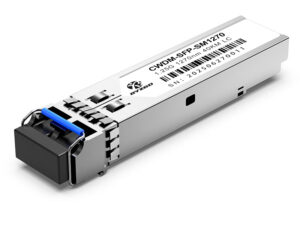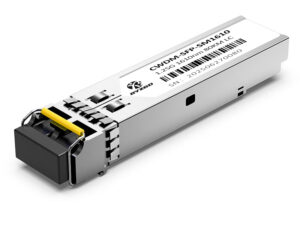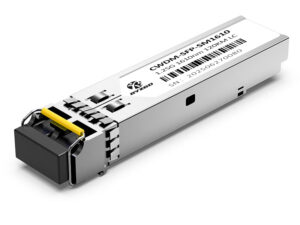Are you looking to grow your network with the installation of expensive new fiber cables? What if you could take the fiber cables in use and, over a single strand of cable, transmit multiple 1G signals and increase the capacity of your network?
The 1G CWDM SFP module does precisely that! Using Coarse Wavelength Division Multiplexing (CWDM), the 1G CWDM modules allow for packing more data into fewer fibers. This technology is not only precious for saving fibers, but it also reduces the costs of deployment.
After understanding how a 1G CWDM module works, reading through the specifications of these products, and examples of best use cases will provide you with the capabilities to manage dense network deployments effectively and efficiently.

1G CWDM SFP Product Lineup: Find the Perfect Solution
The lineup of 1G CWDM SFP products caters to extensive and flexible deployment options for multiple wavelengths in dense applications. Each module supports a specific CWDM channel, with channels deployed every 20 nm, and wavelengths spanning from 1270 nm to 1610 nm.
This presents the opportunity for network design engineers to design a deployment that is cognizant of their existing fiber plant and bandwidth delivery needs. The modules are compatible with a wide variety of switches, routers, and optical devices from various vendors, ensuring smooth operation.
Performance will be consistent with the strictest industry standards, while still conveying the same consistent quality in transmission. The following models are available:
- CWDM SFP 1270 nm–A great option for short to medium distance links with good signal separation.
- CWDM SFP 1290 nm–A favored option for installations requiring reliable data transmission for extended network distance.
- CWDM SFP 1310 nm→1610 nm–Permits extended wavelength options for networks that demand complexity and capacity.
All units are plug-and-play solutions with diagnostic monitoring, making maintenance and troubleshooting simple. The offerings provide flexibility for network planners to deploy or upgrade while maximizing fiber usage and minimizing infrastructure upgrades.
A full catalog of all 1G CWDM SFP offerings is also available for easy comparison or selection depending on the network.

BYXGD-1.25Gb-CWDM-SFP-40KM: The CWDM SFP module operates at 1.25 Gb/s and can transmit over single-mode fiber up to 40 km. The module covers the wavelength range of 1270 nm – 1610 nm with a DFB laser that transmits output power of -5 to 0 dBm using a PIN photodiode with a sensitivity ≤ -24 dBm. The module meets the extinction ratio needed for stable transmission and the LC interface for easy connection.

BYXGD-1.25Gb-CWDM-SFP-80KM: This CWDM SFP module, at 1.25 Gb/s bursting speed, is capable of single-mode fiber transmission distances of up to 80 km. The module operates with wavelengths ranging from 1270 nm to 1610 nm, with the DFB laser transmitting between 0 and 5 dBm and the PIN photodiode with a sensitivity of ≤ -24 dBm. The extinction ratio is 9 dB, and the network interface is via LC.

BYXGD-1.25Gb-CWDM-SFP-120KM:This 1.25 Gb/s CWDM SFP Transceiver meets CWDM system applications, which are easy to hot-plug. It is equipped with a DFB laser, selectable from 0 to 5 dBm in output power, and an APD photodiode receiver with a sensitivity of ≤ -31 dBm. It has an extinction ratio of 9 dB and an LC interface that ensures a tool-free network connection.
Why Choose 1G CWDM SFP? What It Brings to Your Network
With 1G CWDM SFP modules, multiple 1G signals can be sent down a single fiber simultaneously by using Coarse Wavelength Division Multiplexing (CWDM). CWDM is like a highway with multiple colors, where each color (or wavelength) is an independent stream of data going down the same path.
In other words, this technology multiplies the effective bandwidth without putting down multiple fibers. CWDM channels multiple signals through separate wavelengths or channels that are 20 nm apart in the spectrum. Since the wavelengths are separated with enough distance, CWDM will not interfere with each other and enables the most usage of a fiber.
Instead of putting down fiber for each of the signals individually, CWDM makes it more economical to carry multiple wavelengths to and from the single fiber. The primary advantage of CWDM transmission is significant fiber resource savings.
This is important in highly dense networks, where fiber is limited. Furthermore, less fiber is associated with decreased installation costs, increased efficiencies, and reduced cable clutter. 1G CWDM SFP modules accelerate deployment timelines as you can install and terminate less fiber.
To learn more about CWDM technologies, applications, and configurations, take a look at the CWDM vs WDM Article, as it discusses general architecture, compatibility with existing technology and approaches, and industry development trends.
Overall, 1G CWDM SFP modules present a pragmatic and economical approach to network scaling, and even have the possibility of optimizing the existing infrastructure while retaining performance effectiveness.
Deep Dive into 1G CWDM SFP Performance
Familiarity with the technical specifications of 1G CWDM SFP modules is essential in order to understand the requirements for dense network deployments. CWDM SFP modules work by using multiple discrete wavelengths, typically 20 nm apart across the wavelengths of 1270 nm to 1610 nm.
Choosing the correct wavelength pair ensures you won’t interfere with your signals, while also increasing the efficiency of multiplexing. The demand for fiber will vary greatly from traditional 1G SFP modules, as CWDM allows multiple channels on a single fiber and reduces the amount of cables needed.
The careful alignment of wavelengths is crucial, as misalignment can lead to serious signal degradation or signal loss. The complexity of installation will generally increase when deploying CWDM systems due to the need for precise wavelength planning, as well as other multiplexing equipment.
However, this is a small price to pay compared to the reduction in fiber deployment cost and physical infrastructure. The following table compares 1G CWDM SFP with traditional 1G SFP modules with respect to other factors:
Aspect Comparison
| Aspect | 1G CWDM SFP | Traditional 1G SFP |
| Fiber Demand | Single fiber supports multiple channels | One fiber per channel |
| Module Variety | Multiple wavelengths (1270nm-1610nm) | Standard single wavelength (usually 1310nm) |
| Installation Complexity | Higher, requires wavelength management and multiplexers | Lower, plug-and-play with simple cabling |
| Cost | Upfront higher due to multiplexing equipment; lower overall due to fiber savings | Lower initial transceiver cost; higher fiber and cabling expense |
| Typical Applications | Dense metro, campus, or data center deployments requiring fiber conservation | Simple point-to-point or low-density deployments |
When selecting CWDM SFP modules, the primary considerations include ensuring the CWDM wavelengths match at each endpoint so that communications can occur as expected and making sure the power budgets allow for signals to propagate without errors.
When network planners consider these details, they can develop the right balance of scalability, cost, and complexity when looking to upgrade or expand fiber networks with 1G CWDM SFP modules.
Troubleshooting 1G CWDM SFP: Common Issues and Solutions
When deploying 1G CWDM SFPs, you can face other specific challenges, such as wavelength channel conflicts, where wavelengths may be transmitting concurrently, or the assignments may be incorrectly designated, making it impossible for them to transmit effectively together.
This is similar to broadcasting two radio stations on the same frequency. Instead of listening to music, you hear static, or the quality is lost somewhere in the transmission. Other issues you may run into regularly are multi-signal crosstalk, when signals from adjacent channels bleed into the signal you are trying to propagate, and instead of receiving a solid link, you have poor link quality.
Improper fiber connection, dirty connectors, etc., can all contribute to crosstalk, but it is not always the cause. Wavelength mismatches can also contribute to performance issues—remember, you must use complementary wavelengths on both ends of the transmission. Learn how to troubleshoot SFP/SFP+ Modules.
If you have SFPs at each end transmitting the same wavelength, the signal will not be received properly at the opposite end. Once you have established your fault, you can move on to troubleshooting. You can start with several CLI commands, such as:
show interfaces transceiver detail
show interfaces optical
The commands show Tx/Rx power levels, module temperature, and wavelength information, all crucial for narrowing down faults. You can determine if there are power level anomalies or if the wavelengths are not consistent in order to determine mismatches or signal degradation.
The duties of routine maintenance will include cleaning connectors, taking a look at fiber runs for bends or damage, and confirming correct wavelength pairings. It is highly recommended to follow a structured troubleshooting process to ensure that efficiency is achieved and predictable troubleshooting is used to return the 1G CWDM SFP networks to optimum performance.
Successful 1G CWDM SFP Deployment in a Metropolitan Network
A metropolitan communication service provider was challenged with bandwidth demand growth while constrained on fiber infrastructure. Rather than incur the expense and all the costs of new fiber installation, they selected a 1G CWDM SFP-based solution to optimize what they had.
By utilizing CWDM technology, the service provider was able to multiplex a maximum of 18 separate 1G channels on a single fiber pair. This alone resulted in the use of more than 70% less fiber cable than traditional point-to-point links.
Their deployment also simplified cable management and minimized physical space requirements in network closets. The project reduced capital expenditures by approximately 35%, resulting in savings on both equipment and labor costs associated with installation.
The installation time was shortened by weeks, allowing the service provider to meet increased demand quickly without requiring additional time or resource constraints. This successful deployment demonstrated the ability to leverage CWDM SFP modules to execute network expansion plans at scale while minimizing the expenses of new fiber infrastructure.
This was an excellent economic solution for these dense urban environments which were starving for capacity.
Frequently Asked Questions
1G CWDM operates by multiplexing several wavelengths onto one pair of fibers, thus increasing overall bandwidth. 1G BiDi transmits bidirectional data on a single fiber strand utilizing paired wavelengths.
Most modules will operate between 20 km and 80 km based on power budget and network devices.
Yes, but check with both the manufacturer compatibility matrices and firmware levels, as some types of switching devices may have restrictions.
Contact Us For The Best Solution
1G CWDM SFP modules provide an excellent way to increase your fiber usage while decreasing your deployment costs. The ability to send multiple data streams on fewer fibers means network expansion is simpler and less physical infrastructure is required to support existing networks.
Check the variety of product availabilities to find the right fit for your fiber application. For additional questions or custom solutions, reach out to your product’s technical support teams to help assist with your fiber-saving upgrade.
